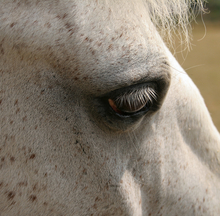Over the past five years, treatment of squamous cell carcinoma in equines has steadily advanced both in the number of cases treated and in the success rate. Squamous cell carcinoma is the most common tumor affecting the eyes and surrounding tissue of horses. Invasion of this type of malignant skin cancer into eye and surrounding areas may result in pain and blindness if untreated.

Light skin - Factor in cancer affecting eyes of horses
The clinical benefits of using photodynamic therapy to treat equine facial carcinomas are far reaching and may allow for treatment of this tumor type in other locations in horses or in other species.
This malignancy commonly affects horses on the cornea, third eyelid or eyelid. Predisposing factors include the breed, Belgians and Appaloosas, poor pigmentation or light-colored skin, and exposure to ultraviolet light from high altitudes or frequent sun exposure.
in fact, any horse with white skin is more susceptible to this type of skin cancer that affects the eyes of horses. Because the skin on the face of the horse tightly adheres to the underlying bone, certain reconstructive procedures cannot be done. Without retaining the eyelid, the eye can't be saved.
Up until a clinical trial to treat this condition at the University of Missouri, the standard method of treatment was surgery followed up with chemotherapy, or freezing, or burning off the tumor, which was not always successful.
The new treatment that Dr. Giuliano at the University of Missouri developed uses photodynamic therapy. After surgery, removal of the tumor, a photo-reactive chemical is injected into the cells where the tumor was. The area is then treated with laser light.
This procedure is different than prior photodynamic therapies in that the photoactive drug used is rather than throughout the entire body.
This treatment does not require a waiting period before treatment, and the horse does n'o have to stay inside because of sensitivity to light.
The study done by Dr. Laura Barnes and mentored by Dr. Elizabeth Giuliano, studied the effect of time between intralesional injection to laser irraditation. The amount of time the drug remains in the tumor and in contact with tumor cells prior to laser light application is an important determinant in the tumor response to therapy. This method of photodynamic therapy is different from other strategies currently used in that the photoactive drug is injected directly into the tumor cells as opposed to the patient receiving a systemic intravenous injection.
The findings of the study suggested that treatment with laser light immediately after the photoactive drug is injected into the tumor results in more effective tumor cell death than laser treatment at later time periods.
Clinically, this therapeutic method has proven to be more effective, requiring fewer treatment episodes, shorter hospital stays, and results in excellent preservation of eyelid function.
Overall the clinical benefits of using this therapy to treat this type of cancer are far reaching and may allow for treatment of this tumor type in other locations or in other species.
Supporters and donors of the ACVO Vision for Animals Foundation funded this study and continue support of vision research.
